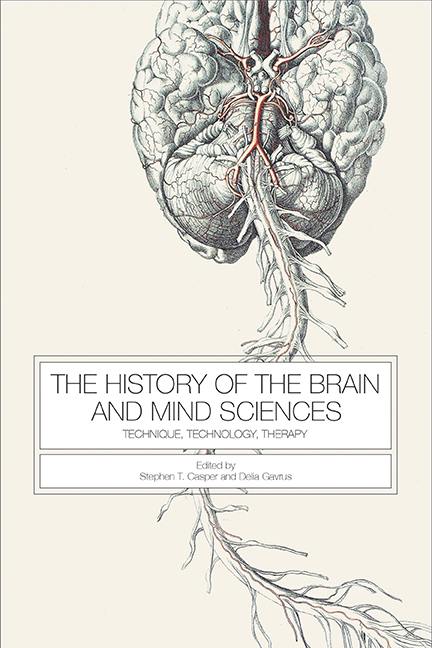Book contents
- Frontmatter
- Contents
- Acknowledgments
- Introduction
- 1 “We Are Veritable Animals”: The Nineteenth-Century Paris Menagerie as a Site for the Science of Intelligence
- 2 “Physiological Surgery”: Laboratory Science as the Epistemic Basis of Modern Surgery (and Neurosurgery)
- 3 Configuring Epidemic Encephalitis as a National and International Neurological Concern
- 4 Circuits, Algae, and Whipped Cream: The Biophysics of Nerve, ca. 1930
- 5 Epilepsy and the Laboratory Technician: Technique in Histology and Fiction
- 6 “What Was in Their Luggage?”: German Refugee Neuroscientists, Migrating Technologies, and the Emergence of Interdisciplinary Research Networks in North America, 1933 to 1963
- 7 Dualist Techniques for Materialist Imaginaries: Matter and Mind in the 1951 Festival of Britain
- 8 A “Model Schizophrenia”: Amphetamine Psychosis and the Transformation of American Psychiatry
- 9 Salvation through Reductionism: The National Institute of Mental Health and the Return to Biological Psychiatry
- Coda: Technique, Marginality, and History
- Bibliography
- List of Contributors
- Index
Coda: Technique, Marginality, and History
Published online by Cambridge University Press: 26 May 2021
- Frontmatter
- Contents
- Acknowledgments
- Introduction
- 1 “We Are Veritable Animals”: The Nineteenth-Century Paris Menagerie as a Site for the Science of Intelligence
- 2 “Physiological Surgery”: Laboratory Science as the Epistemic Basis of Modern Surgery (and Neurosurgery)
- 3 Configuring Epidemic Encephalitis as a National and International Neurological Concern
- 4 Circuits, Algae, and Whipped Cream: The Biophysics of Nerve, ca. 1930
- 5 Epilepsy and the Laboratory Technician: Technique in Histology and Fiction
- 6 “What Was in Their Luggage?”: German Refugee Neuroscientists, Migrating Technologies, and the Emergence of Interdisciplinary Research Networks in North America, 1933 to 1963
- 7 Dualist Techniques for Materialist Imaginaries: Matter and Mind in the 1951 Festival of Britain
- 8 A “Model Schizophrenia”: Amphetamine Psychosis and the Transformation of American Psychiatry
- 9 Salvation through Reductionism: The National Institute of Mental Health and the Return to Biological Psychiatry
- Coda: Technique, Marginality, and History
- Bibliography
- List of Contributors
- Index
Summary
As Delia Gavrus and Stephen Casper point out in their Introduction, technique is crucial to the success and prominence of the contemporary neurosciences. In their day-to-day work, the latter rely on an astonishing array of techniques—technologies and practices—to produce, disseminate, and promote their research. Since the early 1980s, scientists have used positron emission tomography (PET) and functional magnetic resonance imaging (fMRI) to correlate mental states such as hunger, love, even religiosity, to physiological changes in specific regions of the brain; these machines provide evidence of the mind “at work.” Psychoactive drugs can similarly be seen as technologies for producing changes in both physiological and psychological functions. They thus lend support to the idea that the brain is the ultimate substrate of the mind. In addition, technique plays a central role in neuroscientific funding. To give a recent and extreme example, in 2014 the European Commission awarded the Human Brain Project (HBP) more than one billion Euros to be spent over the next decade. The large sum was justified in part by the need to develop new techniques, including neuromorphic computing and neurorobotics. Technique has thus been instrumental in crowning neuroscience queen of the sciences. It is now a reference point for other academic disciplines from across the social sciences and the humanities, which seek to ground, or at least inform, their work through the results of neuroscientific research.
The close relationship between the neurosciences and technique is not simply a contemporary phenomenon; technique has been important throughout their history. But while in the early twenty-first century, technique seems intimately related to the centrality of the neurosciences, once we shift our attention to the past a curious transformation occurs. It is telling that the essays in this volume relate technique, almost without exception, to the marginal. The relationship between centrality and marginality should not be posed in starkly oppositional terms. As Gavrus and Casper note, the marginal, or “that which … appears unusual, unimportant, insufficient, minor, insignificant, on the edge, on the sidelines, [or] flat out wrong” (16), is a shifting category.
- Type
- Chapter
- Information
- The History of the Brain and Mind SciencesTechnique, Technology, Therapy, pp. 257 - 264Publisher: Boydell & BrewerPrint publication year: 2017

